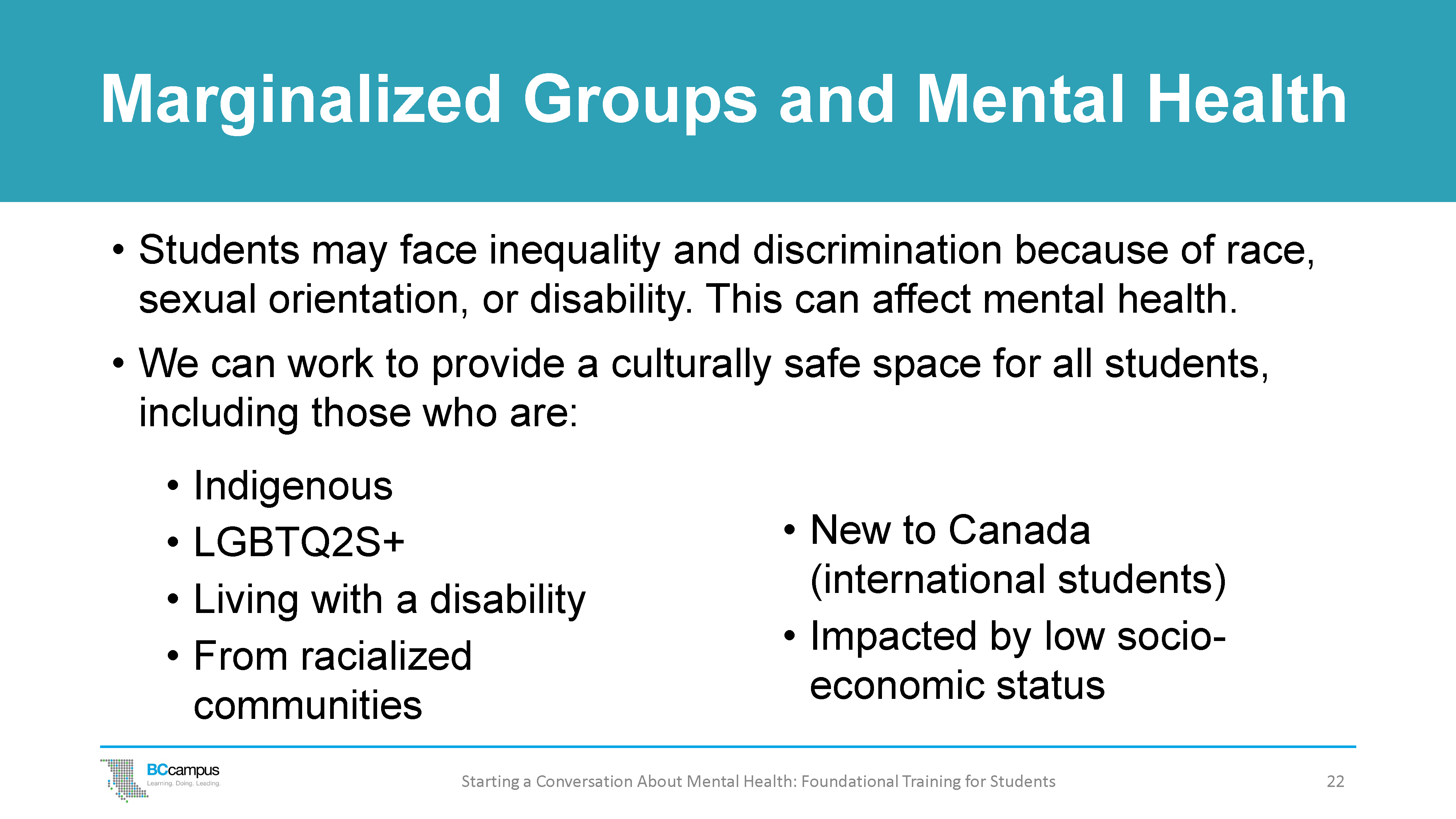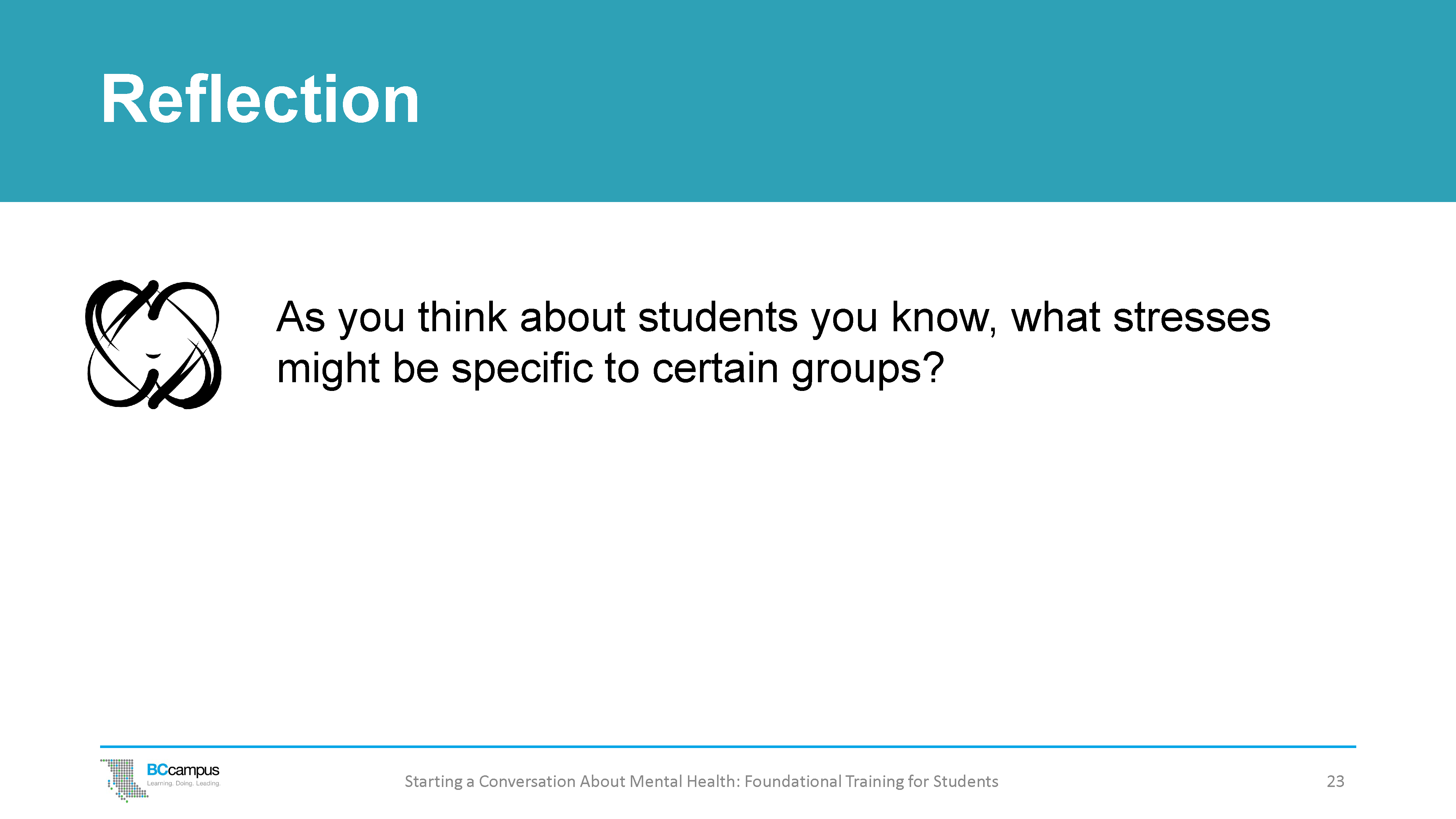4. Marginalized Groups and Mental Health
These slides are available for use with this section of the presentation. For information about downloading the slide deck, see the Introduction.


When we talk about mental health, we also need to be aware of factors like race, sexual orientation, social class, disability, and gender and the unique life experiences and stressors that accompany them. Some students face inequality, discrimination, and violence because of their race, gender orientation, or disability. These unique and specific stressors impact mental and physical health, and these students often experience greater mental health burdens and face more barriers to accessing care and resources.
Indigenous Students
Indigenous students may be struggling as they adjust to living in an urban academic setting after living in a community where they are surrounded by family and neighbours who share the same culture and spiritual beliefs. They may be the first generation in their family to pursue post-secondary education, and they may be missing their home, family, Elders, and community. The impact of residential schools and other colonial policies have created ongoing adversity for Indigenous people, and there is evidence that this has created intergenerational trauma. Many Indigenous students may also lack trust in educational and health care institutions because of the negative or traumatic experiences they or family and friends have experienced in the past.
LGBTQ2S+ Students
People who are LGBTQ2S+ (lesbian, gay, bi-sexual, transgender, queer, two-spirit) are at a much higher risk than the general population for mental health disorders, substance abuse, and suicide.[1] Homophobia and negative stereotypes about being LGBTQ2S+ can make it challenging for a student to let people know about this important part of their identity. When people do openly express this part of themselves, they worry about potential rejection by peers, colleagues, and friends, and this can exacerbate feelings of loneliness. Their health needs may be unique and complex, and health care settings can feel unsafe or uncomfortable for some.
Students with a Disability
Many students live with some form of physical, cognitive, sensory, mental health, or other disability. Students of all abilities and backgrounds deserve post-secondary settings that are inclusive and respectful. Unfortunately, many institutions are not designed to fully support people who need extra accommodation, and students with a disability frequently encounter accessibility challenges and extra barriers to achieving academic success. In addition to navigating the complex environment of a post-secondary institution that is not set up for them, students with a disability also often have to combat negative stereotypes, bias, and discrimination. These many extra challenges can take their toll on mental health.
Racialized Students
Black, Indigenous, and other racialized students have likely faced racism and discrimination throughout their lives. Racism can encompass a range of words and actions, from the overt racism of violence or slurs to microaggressions (everyday, subtle interactions that demean or put down a person based on their race). Sometimes microaggressions are not intentional, but they can still be very harmful, and they are a form of racism that many students experience. These repeated negative interactions can be overwhelming at times, especially in post-secondary spaces where a student could reasonably assume they would be free from any form of bullying, harassment, or discrimination.
Racism and discrimination in various forms can have a significant impact on a student’s mental health and can lead to increased risk of depression or suicide, increased levels of anxiety and stress-related illnesses, and post-traumatic stress disorder.
International Students
Both undergraduate and graduate international students are often under a lot of pressure, and the stakes may be very high for them: their tuition is expensive, they’ve travelled a long way to attend a post-secondary institution in B.C., and they feel a lot of pressure to do well academically. They may be struggling to adjust to a new culture or learn English, and they may be missing home, family, and friends. The understanding of mental health and wellness differs among cultures, and international students may have a different understanding of how mental health impacts academic performance, and they may not be aware of the support systems available to them when they arrive. There are also system barriers that international students may face, including visa requirements, that don’t allow for flexibility in course workloads when they are struggling.
Socio-economic Status
Post-secondary education puts significant financial strain on students. Students from lower-income families are especially vulnerable to financial uncertainties and pressures, which take a toll on mental health. These students are frequently juggling work with classes, and they can’t rely on financial support from their families. Some students may be the first in their family to pursue post-secondary education, and this can add stress. Given the high cost of renting in many locations, some students have trouble finding appropriate accommodation and the worry of being homeless is a significant concern.
What We Need to Keep in Mind
It’s important to remember that we all have underlying assumptions and biases about others, which may impact how (and if) we provide support. While educating ourselves about mental health is an important component of supporting others, it is also important to take some time to learn more about your own unconscious biases and the impacts of systemic discrimination and historical oppression.
We need to take care to understand and acknowledge oppressions faced by Indigenous people, people who are LGBTQ2S+, people with disabilities, and people from racialized and other marginalized groups. By providing a culturally safe environment, we can all play a role in ensuring that each student feels that their personal, social, and cultural identity is respected and valued.
It is helpful to know the campus and community resources for students from marginalized groups. Connecting an Indigenous student with an Elder or with someone from Indigenous services or introducing an LGBTQ2S+ student to a pride centre on campus can help to reduce feelings of isolation and help students feel heard and supported. We’ll talk more about supports and referrals a bit later in the session.

ACTIVITY: Reflection
Ask participants to think about the students they work with and consider the stresses that may be specific to certain groups.
You could also ask participants to discuss the services or supports they think might be helpful for students who experience discrimination or inequities. If participants don’t know, that’s okay. This is an opportunity to share knowledge, and you can mention that you’ll be discussing resources a bit later in the session.
Text Attribution
- This chapter is by Barbara Johnston (CC BY 4.0 License).
Media Attribution
- Reflection of hearts icon by Álvaro Bueno, ES is used under a CC BY 4.0 License.
- U.S. Office of Disease Prevention and Health Promotion. (n.d.). Healthy people 2020: Lesbian, gay, and transgender health. https://www.healthypeople.gov/2020/topics-objectives/topic/lesbian-gay-bisexual-and-transgender-health ↵

